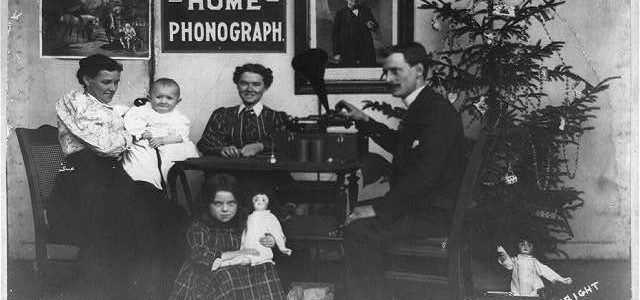

Tagged: gender, Progressive Era, recorded sound, technology
by Dr. J. Martin Vest
In my doctoral dissertation “Vox Machinae: Phonographs and the Birth of Sonic Modernity, 1877-1930,” I presented a cultural history of the early recording industry in close conversation with the so-called “New Materialisms.” Drawing on Science and Technology Studies (STS), phenomenological philosophy, and other strains of materialist literature, I sought to make sense of the ways in which machines and other material entities exercise agency over cultural processes. How, in other words, did the early phonograph itself—with its motor and governor and nuts and bolts and belts—shape how people responded to recorded sound? How might the ritual of cleaning, sorting and storing one’s black shellac or wax cylinder records have molded one’s perceptions of what lay in their grooves?
As I turned to the task of converting “Vox Machinae” into a scholarly monograph, however, I realized that I had produced a fairly top-heavy account. Corporate records and publications of Edison’s National Phonograph Company and the Victor Talking Machine Company had allowed me to detail the efforts of large firms to control the practices and meanings associated with recorded sound consumption. I knew what these machines and records were supposed to do in purchasers’ homes. Consumers, however, have never passively soaked up manufacturers’ and advertisers’ prescriptions, and I was certain that my subjects were no exception to this general rule. So, I began to wonder, what did those first generations of audiophiles think about their phonographs and records? What did they do with them and how did they employ them in the fashioning of new worlds?
I have begun searching for answers to these questions, but unearthing the historical experiences of a technology’s early adopters can be difficult, taxing the researcher’s creativity and pushing him or her into less-than-traditional avenues of investigation and argumentation. My investigations have led me to a unique set of primary sources—early home sound recordings. Beginning in the 1890s, Thomas Edison’s National Phonograph Company and the Columbia Graphophone Company began marketing home phonographs, which, unlike later 78 RPM “record players” could be used for playback and recording [image 1].
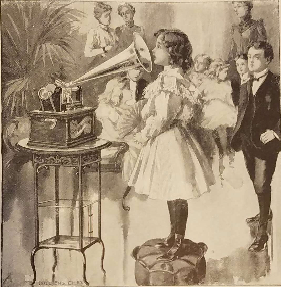
Image 1: A stylized depiction of home recording with the Columbia Graphophone. The Columbia Record. Vol. III, No. 3, March, 1905.
Americans eventually abandoned these phonographs for the passive entertainment of the 78 RPM disc record championed by the Victor Talking Machine Company and its imitators. Before doing so, however, they produced untold numbers of wax cylinder sound recordings [image 2], a depressingly small number of which have survived into the twenty-first century. Fortunately, a growing number of these surviving early home recordings (as well as their commercially-released counterparts) are held at the University of California—Santa Barbara, and many of them have been made available to the public through UCSB’s Cylinder Audio Archive Project.
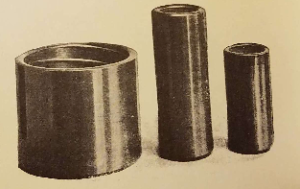
Image 2: Early phonograph users recorded their messages on wax cylinder “blanks.” Shown here are blanks for use with various Edson home and office phonograph models. Bettini Phonograph Laboratory New York, “Bettini Micro- Reproducers, Recorders, Phonographs, Graphophones, and Supplies” [reproduction] (Brooklyn: A. Koenigsberg, 1974).
To take a non-traditional source and extract from it fresh insights about the past is the stuff of scholarly heroics. We romanticize this sort of thing, and for good reason: it’s hard. Business ledgers and photographs and textiles reveal meaningful stories only under the most methodical of investigations conducted by creative interrogators. My preliminary work with early home recordings has affirmed this general pattern. It has been exceedingly difficult, for example, to listen past their superficial content to identify something more pertinent to my research. An actor’s florid “thank you” note, recorded in 1911; a sonic menagerie called into being for the benefit of posterity sometime between 1890 and 1930; prayers; skits; banjo solos; bugle calls; what can an historian of media and technology make of all this aural bric-a-brac?
As it turns out, there are insights to be gleaned from these documents. For example, one is struck by the degree to which early phonographic use was gendered in ways intuitive and not-so-intuitive. Men and boys regularly recited, joked, or sang and played for the home talking machine unaccompanied by women. Women and girls, on the other hand, were very often sonically chaperoned by a member of the opposite sex when they stood before the phonograph’s horn—especially when they were speaking. Conversely, women and girls often did make recordings without male accompaniment when attending to those sonic duties handed down to them from the parlor culture of the Victorian period—especially singing and reciting. All of this suggests that the phonograph was, in some ways, assimilated into existing patriarchal domestic arrangements, with men claiming prerogative over technological gadgetry like phonographs, while women continued to perform as agents of uplifting domestic culture.
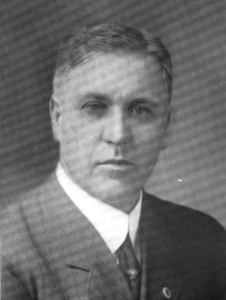
Image 3: Omaha, Nebraska, Businessman, Ralph Sunderland. Sunderland was an enthusiastic early adopter of the home phonograph who regularly sent recorded messages to his father in Oakland, California. In 1907, he introduced his angsty twenty-year-old nephew, Roy, to the phonograph. James Sunderland, Jabez Thomas Sunderland, and Lester Thomas Sunderland, Biographical Sketch and Recollections of the Lives of Thomas Sunderland (2d) and Sarah Broadhead Sunderland (Lovell)(Kansas City, Missouri: L.T. Sunderland, 1914).
This much might be expected, but surprises do emerge from the recordings as well. For example, early home recordings evidence a sense of relaxed and familiar exchange between family members that squares poorly with the era’s dour-faced photographic portraits. Sometime between 1908 and 1911, for example, the Chubb and Moses families gathered for a meal followed by speeches. The wax cylinder recordings of these proceedings reveal a domestic scene in which women could joke and laugh boisterously in mixed company—at least when the phonograph was on. Similarly, children and young adults performed their independence for the phonograph’s recording horn and poked fun at the pretensions of adulthood. In this 1907 cylinder, Ralph Sunderland [image 3] narrates the story of his nephew, Roy, who has recently been turned away at the voting booth—he was just shy of his twenty-first birthday. Roy uses his turn at the recording horn to comment on his coming birthday and the pretense that it will transform him into a “real man.” His oozing, angsty sarcasm will sound familiar to parents and other victims of the modern teenager (or young adult.)
The years before 1900 did, in fact, see a substantial erosion of tried-and-true verities of American culture and society by the forces of modernity. Kathy Peiss has argued, for example, that commercial amusements, like dancehalls and movie theaters, provided venues in which working class women could shake off some of the strictures of an older, patriarchal culture; assert a degree of independence; and cultivate less formal relationships with men. It is not entirely surprising, then, to hear on the earliest home recordings evidence of a relaxing (though still very powerful) patriarchy. In this sense, the first generation of home recordings provides a sonic snapshot of a slowly liberalizing domestic politics.
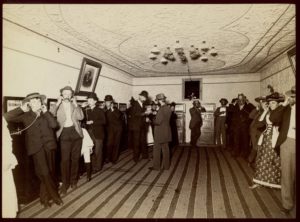
Image 4: Beginning in the 1890s, the phonograph entered the lives of millions of Americans. Outfitted with nickel-in-slot attachments and left in public “phonograph parlors,” these talking machines dispensed pre-recorded music, skits, jokes and even sermons to a novelty-hungry public. Photo, courtesy of Leonard DeGraaf, Thomas Edison National Historical Park.
At the same time, we should be suspicious of any claim that sound recordings represent the sonic past in a passive, objective way. Much of the work I did in my dissertation was in showing how early sound recording technology represented an ensemble of material and ideational elements, all of which mattered for the technology’s social and cultural effects. More concretely, the physical presence of the phonograph in American homes likely facilitated and encouraged new activities and new ways of being and did not merely record transformations already underway. The phonograph itself was a likely vector for those transformations in domestic culture I have already discussed. During the 1890s it had figured as a regular fixture in urban nickel-in-slot arcades [image 4], spaces where anonymous, heterosocial interaction flourished, and which were the subject of constant attack by social conservatives as dens of moral peril. In a word, phonographs and machines like them were fun. Their movement into the parlor, then, smuggled a bit of Coney Island into the home and might help to explain the carnivalesque relaxing of gender and age hierarchies evident in the recordings. If public amusements represented the entering wedge of a more liberal cultural politics, their importation into the home in the form of phonographs brought these relations into the very heart of American private life.
Working with these recordings, then, has helped me flesh out a fuller picture of recorded sound’s place in the Progressive Era home, my future chapter drafts will benefit very much from this experiment. At the same time, much of these recordings’ value stems from their capacity to stir, provoke, and delight the historical imagination. They allow us to hear—even in heavily-mediated form—the lives of turn-of-the-century Americans, thereby intensifying our affective connection to the past. Not all of that, of course, can be passed through the mangle of scholarly prose. But why should it have to? Go listen yourself!
J. Martin Vest is a lecturer in the University of Michigan Department of History. He can be reached at jacquesb@umich.edu.
This post is the first in a series of posts written by some of the participants in the SHGAPE-sponsored lightning round at OAH 2019, “The Gilded Age and Progressive Era: Emerging Scholarship in the Field,” organized by Cynthia Heider.
Cover image: “Man, two women and two children listening to phonograph…” Library of Congress Prints and Photographs Division Washington, D.C. 20540 USA, https://www.loc.gov/item/97504441/
Receive a year's subscription to our quarterly SHGAPE journal.